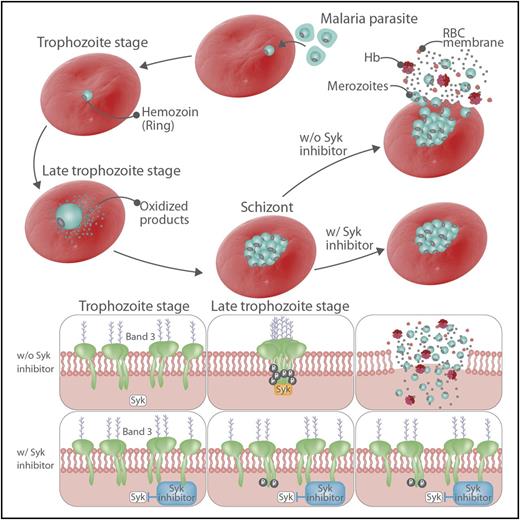In a new effort to tame the global menace of malaria, Pantaleo et al describe, in this issue of Blood, the effect of Syk inhibition on the malarial parasite.1
The role of band 3 in the life of the malarial parasite with (w/) and without (w/o) Syk tyrosine kinase inhibition. Hb, hemoglobin; p, phosphorylation of band 3; RBC, red blood cell. Professional illustration by Somersault18:24.
The role of band 3 in the life of the malarial parasite with (w/) and without (w/o) Syk tyrosine kinase inhibition. Hb, hemoglobin; p, phosphorylation of band 3; RBC, red blood cell. Professional illustration by Somersault18:24.
Malaria remains one of the deadliest infections throughout the world. Almost 200 million cases of malaria occur every year with 70% of malarial deaths occurring in children <5 years old.2 Because the malarial parasite is a nimble mutater, eradication efforts have often come at the price of drug resistance. Red cell band 3 is a transmembrane anion exchange protein that plays an important role in the formation of a deformable but cohesive red cell as it helps connect the cytoskeleton to the membrane. However, band 3 is sensitive to hemichromes and other reactive oxygen species effects and, when phosphorylated by erythrocyte tyrosine kinase, band 3 clusters and causes membrane destabilization leading to hemolysis, formation of microparticles, release of red cell membranes and free, as well as microparticle-enclosed, hemoglobin.
Band 3 has also been shown to be important for the malarial parasites Plasmodium falciparum and Plasmodiumvivax.3,4 As depicted in the figure, the parasite co-opts erythrocyte tyrosine kinase and activates the process of band 3 phosphorylation for its own benefit; the resultant destabilization of the membrane allows for egress of its merozoites and has been implicated in the ability of P falciparum to form knobs and adhere to the microvasculature.5 Using synchronized P falciparum culture models, the authors show a progressive increase in band 3 phosphorylation from the ring to the trophozoite stage until the schizont stage. This is accompanied by an increase in band 3–containing microparticle formation and an increase in hemolysis. By adding a Syk tyrosine kinase inhibitor (TKI) that interferes with phosphorylation of band 3, Pantaleo and colleagues demonstrate that they can inhibit these red cell membrane modifications and decrease hemolysis, microparticle formation, and (as shown in their accompanying video) suppress merozoite egress leading to marked decreases in overall parasitemia as the trapped merozoites die. Importantly, Syk inhibition appears to work at 2 levels: while the lower dosing affects the cell membrane, the higher doses appear to have a direct effect on future cell-cycle replication efforts.
Pantaleo et al propose that prolonged entrapment of merozoites within Syk inhibitor–treated cells causes parasite degradation and disintegration. However, although the degree of parasitemia is clearly a factor in morbidity, another issue, and what makes Pfalciparum so deadly, is the transformed red cell’s adherence to, and subsequent occlusion of, the vessel wall through knobs. Membrane knobs are formed at the trophozoite stage and mediate the adhesion of P falciparum to endothelial cells. In this study, the authors could not demonstrate any morphologic effect of the Syk inhibitors in knob formation. Whether this is a dose/timing issue or due to other compensating mechanisms from the parasite itself is not yet clear and warrants further investigation.
The value of Syk inhibition at present seems to be as a supplement to immediate treatment in combination with other currently available antimalarials. Particularly noteworthy is that these data were using specific Syk TKIs. Syk inhibitors like R406 are in various stages of development and trials are currently under way investigating Syk inhibition in a wide range of disorders from chronic immune disorders such as immune thrombocytopenic purpura to malignancies such as retinoblastoma. Given their general safety in these initial trials, a case can be made for a clinical translational trial of a Syk TKI in malaria.
But there is a potential for other uses of Syk inhibition in hematology. Many red cell membrane disorders involve band 3, from hereditary spherocytosis and glucose-6-phosphate dehydrogenase favism to Streptococcus-mediated hemolysis.6-9 Indeed, many of the pathologies of sickle cell anemia involve band 3 and there might be benefit from therapies that decrease band 3 clustering and allow for membrane stabilization, decreased microparticle formation, and decreased free hemoglobin.10
Given the high frequency of both sickle cell anemia and malaria in Africa, Syk inhibition has the intriguing potential for benefit (in combination with currently accepted effective therapies) on many levels for several disease processes.
Conflict-of-interest disclosure: The author declares no competing financial interests.


This feature is available to Subscribers Only
Sign In or Create an Account Close Modal